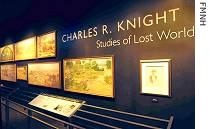2007年VOA标准英语-Paleo-Artists Depict Prehistoric Worlds for Mod(在线收听)
Los Angeles
14 May 2007
Dinosaurs and other prehistoric creatures hold an enduring fascination, especially to the artists known as paleo-artists who bring the ancient animals to life. Mike O'Sullivan reports on the work of two paleo-artists, now on display in California and Florida.
 |
| Charles R. Knight exhibit at the Florida Museum of Natural History |
Jones says Knight inspired generations of scientists, by bringing fossils to life. The artist's paintings adorn the walls of great museums, from the American Museum of Natural History in New York to Chicago's Field Museum and the Natural History Museum of Los Angeles County.
Knight died in 1953, and since then, our understanding of dinosaurs and other ancient creatures has changed. Dinosaurs were once viewed as sluggish giants, but Jones says the huge creatures were energetic and agile, and Knight sensed that.
"They were more vigorous, and more successful and more animated than some of the earlier paintings would seem to indicate," said Douglas Jones. "I hasten to add that in many ways, Charles Knight led the way because he painted some of the dinosaurs in their more active poses, and it was the paleontologists whose paradigm of a sluggish reptilian view held them back."
In addition to dinosaurs, Knight painted such later ice-age creatures as mammoths, saber-tooth cats and giant sloths, and ancient fish that were ancestors to modern marine life.
Seven of Knight's paintings, as well as a self-portrait, are on display in the Florida museum in a special exhibition called Charles R. Knight: Studies of Lost Worlds.
In California, William Stout is a modern paleo-artist who is completing 12 large murals for the San Diego Natural History Museum. He was inspired by Knight's paintings, but was set on his career path at an early age when he saw a classic fantasy film that featured a gigantic ape.
"They had a re-release of the original 1933 King Kong," said William Stout. "And I think it did damage at a genetic level." [this is a joke, meaning the film had a great impact on him.]
King Kong, with special effects created by Willis O'Brien, was one of several films inspired by the work of Charles R. Knight. The special effects pioneer Ray Harryhausen also credits Knight as an inspiration. Harryhausen's films include another tale of a giant ape, Mighty Joe Young, and The Beast From 20,000 Fathoms.
 |
| One of Bill Stout's paintings |
He wrote a best-selling book about dinosaurs in 1981, updated in 2000 as The New Dinosaurs. He says, like Charles R. Knight, he is a communicator.
"I see paleo-artists as conduits to the public on behalf of the scientists," he said. "They take scientific papers and scientific ideas that are pretty hard for the public to digest, put them into visual terms, and get the public very excited."
Douglas Jones says the paintings of Charles Knight, some 100-years-old, still fascinate visitors to the Florida Museum of Natural History.
"The paintings do not seem to have lost anything in terms of their interest to the public, and in a day when the kids are increasingly exposed to electronic media, it is gratifying to see how many of them will stop in front of these paintings with their mom or dad or their grandparents, and point to them and talk about the unusual creatures that they see in these paintings," he said. "So I think they still have that capacity to ignite a young person's imagination."
Rhoda Knight Kalt, the artist's granddaughter, says adults get just as excited when they see her grandfather's pictures.
"It is hard to believe such creatures once inhabited the earth," said Rhoda Knight Kalt. "And they were really here. This is not in somebody's head. They were really here. So what he did was, he brought alive a world that nobody had seen, but it actually existed."
The land that is now Florida was under water in the time of the dinosaurs, but was rich with life in the ice age, so the Knight paintings on display at the Florida museum show that more recent period, which ended about 10,000 years ago.
Bill Stout's murals at the San Diego Natural History Museum cover millions of years of biological history.